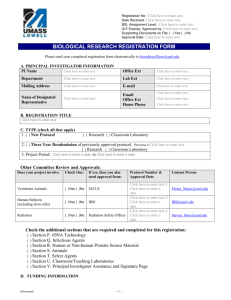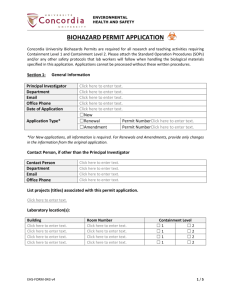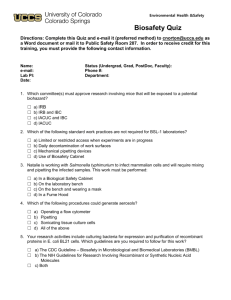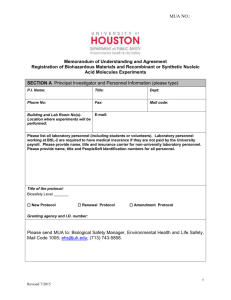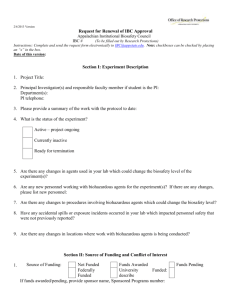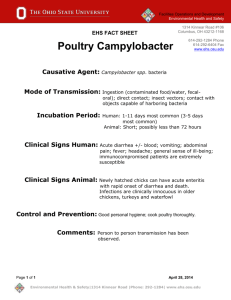IBC No - UMass Lowell
advertisement
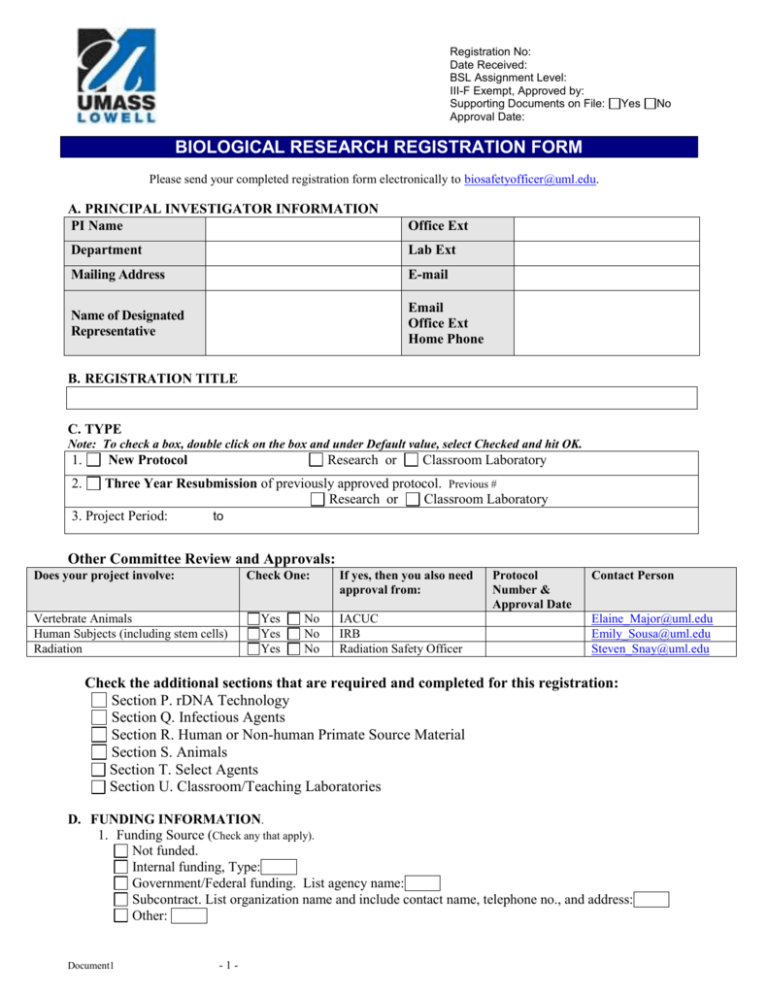
Registration No: Date Received: BSL Assignment Level: III-F Exempt, Approved by: Supporting Documents on File: Approval Date: Yes No BIOLOGICAL RESEARCH REGISTRATION FORM Please send your completed registration form electronically to biosafetyofficer@uml.edu. A. PRINCIPAL INVESTIGATOR INFORMATION PI Name Office Ext Department Lab Ext Mailing Address E-mail Name of Designated Representative Email Office Ext Home Phone B. REGISTRATION TITLE C. TYPE Note: To check a box, double click on the box and under Default value, select Checked and hit OK. 1. New Protocol Research or Classroom Laboratory 2. Three Year Resubmission of previously approved protocol. Previous # Research or Classroom Laboratory 3. Project Period: to Other Committee Review and Approvals: Does your project involve: Check One: Vertebrate Animals Human Subjects (including stem cells) Radiation Yes Yes Yes No No No If yes, then you also need approval from: IACUC IRB Radiation Safety Officer Protocol Number & Approval Date Contact Person Elaine_Major@uml.edu Emily_Sousa@uml.edu Steven_Snay@uml.edu Check the additional sections that are required and completed for this registration: Section P. rDNA Technology Section Q. Infectious Agents Section R. Human or Non-human Primate Source Material Section S. Animals Section T. Select Agents Section U. Classroom/Teaching Laboratories D. FUNDING INFORMATION. 1. Funding Source (Check any that apply). Not funded. Internal funding, Type: Government/Federal funding. List agency name: Subcontract. List organization name and include contact name, telephone no., and address: Other: Document1 -1- E. PERSONNEL AND TRAINING Provide names, title, and applicable training for all personnel involved. Note: Training certification as appropriate for the research is required for all PIs, as well as any faculty, students or staff involved in handling biohazardous materials. EHS Lab Safety and Biosafety/BBP training must be taken in person (http://www.uml.edu/ehs/Training_Schedule.html), and then renewed every year (Lab Safety & BBP) or three years (Biosafety). (Biosafety and BBP training can be renewed via on-line training at www.citiprogram.org.) For work with animals or human subject research, additional training is required. For more information, go to http://www.uml.edu/Research/OIC/default.aspx Name and Title Email Address PI: Training Completed EHS Lab Safety: Date: EHS Biosafety/BBP: Date: CITI Basic: Date: CITI BBP: Date: CITI rDNA: Date: CITI Animal: Date: EHS Lab Safety: Date: EHS Biosafety/BBP: Date: CITI Basic: Date: CITI BBP: Date: CITI rDNA: Date: CITI Animal: Date: EHS Lab Safety: Date: EHS Biosafety/BBP: Date: CITI Basic: Date: CITI BBP: Date: CITI rDNA: Date: CITI Animal: Date: EHS Lab Safety: Date: EHS Biosafety/BBP: Date: CITI Basic: Date: CITI BBP: Date: CITI rDNA: Date: CITI Animal: Date: EHS Lab Safety: Date: EHS Biosafety/BBP: Date: CITI Basic: Date: CITI BBP: Date: CITI rDNA: Date: CITI Animal: Date: Enter additional personnel and training information here if applicable: F. STUDY OBJECTIVES 1. In one paragraph, provide a project description in lay language (i.e. language that could be understood by students or community members). 2. Describe the overall purpose and goals of the project in a minimum of one paragraph. For teaching registrations, this information is captured in Section U, question 2. G. EXPERIMENTS AND TECHNIQUES Explain the experiments and techniques that involve biological materials. Provide enough detail to allow the IBC to understand the risks associated with the use of biological materials. (By answering the following questions, the IBC generally can get enough information to understand the processes proposed: what biohazardous materials are used, why used, how used, where used, when used, and how much is used.) Document1 -2- H. BIOLOGICAL MATERIALS Identify each biological material and its source (i.e. where the material was obtained, purchased, or collected). Biological Material Source Enter additional biological materials and source information here if applicable: I. COLLECTION AND TRANSPORT OF MATERIALS 1. 2. 3. 4. 5. Are the materials listed in this registration being purchased? Yes No If not purchased, how are the biological materials obtained? How are the materials transported? The maximum total volume transported is: (include units). The maximum container size used during transport is: (include units). J. RISK GROUP AND BIOSAFETY LEVEL Identify the risk group and highest biosafety level required for the project (for guidance, refer to http://oba.od.nih.gov/rdna/nih_guidelines_oba.html and/or http://www.cdc.gov/biosafety/publications/bmbl5/BMBL.pdf). NOTE: OSHA regulations require any human derived cell lines or primary tissues to be designated as RG-2 and BSL-2. Check One: RG-1 RG-2 RG-3 Check One: BSL-1 BSL-2 BSL-3 Explain the rationale for the biosafety level requirement: K. LABORATORY INFORMATION List ALL labs/facilities where work will be conducted (check all that apply). Building Room Number Biological Safety Cabinet Sharps Container Autoclave Biological Waste Disposal Box EHS Authorized Sink Disposal Satellite Waste Area 1. Will the materials be transferred between the buildings and/or rooms? Yes No (All buildings and rooms should be noted in the table above.) If yes, check the box below indicating you understand and comply with the following: All materials will be transported in closed and unbreakable secondary containers. Document1 -3- L. ROUTINE CLEANING AND DECONTAMINATION At UMass Lowell, all biohazardous materials must be cleaned, disinfected and decontaminated according to the approved EHS Standard Operating Procedure (SOP) specific to each type of material. If you have any questions, contact the Biosafety Officer at Ruth_Medina@uml.edu or at extension 2618. Answer each question below regarding the routine procedures to be followed for cleaning and decontamination of work surfaces, instruments, equipment and reusable glassware by checking the appropriate box. 1. Decontamination of reusable glassware contaminated with biohazardous materials: I agree to abide by the requirements of SOP-BIO-008 – Decontamination of Large Glassware used with Biological/Biohazard Materials. Not applicable 2. Decontamination of equipment and surfaces (includes centrifuges, biosafety cabinets, open bench surfaces, etc.): I agree to abide by the requirements of SOP-BIO-005 Not applicable M. WASTE GENERATION AND DISPOSAL At UMass Lowell, all biohazardous materials must be decontaminated, disposed of and transported according to the approved EHS Standard Operating Procedure (SOP) specific to each type of material. If you have any questions, contact the Biosafety Officer at Ruth_Medina@uml.edu or at extension 2618. Answer each question below regarding the procedures to be followed for waste generation, disposal and transportation by checking the appropriate box. 1. Disposal of solid biological waste (i.e., includes plastic lab ware such as culture flasks, plates, petri dishes, pipette tips, plastic pipettes and tubes that have been used with biological materials and may include agar): I agree to abide by the requirements of SOP-BIO-003a – Biohazardous Waste Disposal – Solid Waste. Not applicable 2. Decontamination and disposal of liquid biological waste (i.e., includes culture media, effluents or supernatant collected after centrifugation or filtration): I agree to abide by the requirements of SOP-BIO-007 – Decontamination and Disposal of Liquid Waste. I will be submitting a Non-Hazard Waste Determination Form for liquid waste sink disposal. I will be collecting biological waste in a hazardous waste satellite area. All liquids that contain any chemical hazard, except bleach used for decontamination, should be collected in a hazardous waste satellite area. Not applicable 3. Disposal of sharps and broken glassware contaminated with biohazardous materials (i.e., needles, blades, syringes, scalpels, lancets, broken glassware): I agree to abide by the requirements of SOP-BIO-002 – Sharps Disposal. Not applicable 4. Will any radioactive biological waste be generated? Yes a) Estimated amount per week? b) Has radiation safety approved this? Yes No No 5. Describe how waste will be transported if applicable (i.e., procedure for transportation to autoclave): Document1 -4- N. GENERAL SAFETY INFORMATION 1. 1. Describe the potential risks associated with exposure to the material or organism(s) used. Where appropriate, group material(s) and organism(s) together by risk group to describe potential illnesses and symptoms: (almost all materials pose some risk if ingested by or accidentally injected into humans). a. I will be using E. coli K12 and/or derivatives. I understand that these organisms are enfeebled and will not cause human health effects. Note: For manipulations of these cells for rDNA technology, complete Section P. b. I will be using human or non-human primate cell lines or human cells or samples. I understand that even if purchased from commercial vendors, these cell lines are considered by OSHA to be a risk for blood borne pathogens (i.e., HIV, hepatitis, etc.). Note: For use of these cells, complete Section R. c. I will be using other potentially biohazardous materials. Describe the potential symptoms associated with exposure to the material or organism(s) used: 2. Describe procedures that will be put in place to prevent these potential exposures: 3. Identify equipment used during the study that could potentially aerosolize the material and describe measures implemented to prevent aerosol exposure. Equipment Check all that apply Not Applicable Aerosol exposure prevention plan Not Applicable Blender Tissue Grinder Cell sorter Centrifuge Vortex Ultrasonicator Other: 4. Describe laboratory procedures that pose a risk of exposure to the biohazardous material(s), for example plating, injection, use of sharps, transfer, and/or counting of cells: 5. Will sharps be used during the study (needles, blades, glass slides, etc.)? Yes NOTE: Plastic pipette tips are not considered sharps. No 6. Indicate the type of personal protective equipment (PPE) required during all procedures requiring handling or manipulation of the biological materials. Type of PPE Gloves Safety glasses Closed-front gown Document1 -5- Check all that apply Lab coat Shoe covers Face shield Respirator type: Other: 7. Identify immunizations/vaccinations recommended for personnel working with the biological materials: Tetanus Rabies Hepatitis Other: Click here to enter text. O. ACCIDENTAL EXPOSURE AND SPILLS NOTES: a) Any time personnel/student is uncomfortable cleaning up a spill, regardless of volume, call x2911 for assistance. b) Any time a spill occurs in a common area, call x2911 for assistance. c) For questions 1, 4 and 5, check all of the boxes to indicate you understand the recommended procedures to follow. 1. If someone is exposed to biohazardous materials or organisms, I understand the action plan will be as follows (the first 3 are required by the UMass Lowell BBP Exposure Control Plan): If personnel are exposed to potentially infectious materials, the person should immediately wash the affected area with soap and water then follow the reporting procedures outlined in the UML Bloodborne Pathogen Exposure Control Plan. Arrangements will be made for the appropriate medical treatment and follow-up. An incident report will be completed by the exposed person and filed with EHS. If other, indicate here: 2. Indicate how staff/personnel will be educated and trained to handle the materials safely, prevention of spills and exposure, handling of spills and exposure and potential symptoms and illnesses that may result from exposure (check all that apply). Chemical Hygiene Plan (which includes chemical materials) UMass Lowell Biosafety Manual / Exposure Control Plan (BBP) Agent specific training provided by the PI Standard Operating Procedures available in laboratory. Other: 3. For spill planning, what is the maximum volume of the registered materials that will be used at any time? 4. Small (20 mL or less) accidental, low hazard spills and/or releases of the biohazardous material or organism will be handled as follows: Wearing PPE (at a minimum, lab coat, gloves and safety glasses), surround the spill with paper towels and cover the small spill with freshly prepared 10% bleach, and let sit for 20 minutes. Removed the soaked paper towels and dispose them in the biohazard bag for routine EHS pickup. Document1 -6- Wearing PPE (at a minimum, lab coat, gloves and safety glasses), if the small spill includes broken glass, surround the spill with paper towels, pour freshly prepared 10% bleach over the spill and let sit for 20 minutes. Pick up the broken glass with tongs or using two dust pans and place the broken glass in a sharps container or discard in a broken glass receptacle. Dust pans or tools such as tongs can be treated with 10% bleach after use. Do not pick up glass with gloved hands. When all of the debris has been removed, the area should again be decontaminated with freshly prepared 10% bleach as above. Other: 5. Large (greater than 20 mL) accidental spills and/or release of any biohazardous material or organism will be handled as follows: Call x2911. Identify your name, building location, material, quantity and if anyone was hurt. ☐ Other: P. RECOMBINANT DNA TECHNOLOGY The CITI module on NIH Guidelines for Research Involving Recombinant and Synthetic Nucleic Acid Molecules is required for this work. Refer to Section E. For guidance, refer to http://oba.od.nih.gov/rdna/nih_guidelines_oba.html 1. Describe inserted/altered genetic elements (include origin and biological function): a) The inserted genetic material encodes (check all that apply): Oncogene Immunomodulator Toxin Tumor suppressor inhibitors Anti-apoptotic factors Other, Explain: b) Indicate the source of DNA/RNA sequences (include genus, species, gene name, abbreviation): c) Are you cloning >2/3 of the genome? Yes No d) What are the potential biohazards of the product produced by this gene (if you have references to support your assessment, please include)? e) Recombinant plasmid(s)/vector(s) used to manipulate and/or express the gene(check those that apply): Bacterial Plasmid Adenoviral Retroviral Adeno-associated viral Lentiviral Poxviral Herpes viral Other mammalian virus (specify): 2. Will this project, at some point, require the release of organisms containing recombinant molecules into the environment? Yes No. If yes, explain: 3. Will there be any attempt to transfer rDNA molecules in vivo to plant or animal systems (other than tissue culture)? Yes No. If yes, explain: Document1 -7- 4. Will this project require large-scale fermentation (>10 liters) of organisms containing recombinant DNA molecules? Yes No. If yes, explain: Q. INFECTIOUS AGENTS (This does not include use of human tissue or body fluids) As the PI, I understand that I will be responsible to train personnel to safely handle these materials in the laboratory. 1. Agent Identification. List biohazardous agent risk group: 2. Hazards. Is the agent infectious to humans? Is the agent infectious to non-human animals? Is the agent infectious to plants? Yes Yes Yes No No No If yes, answer the following questions: a) b) c) d) e) Susceptible hosts: Infectious dose information (if you have references to support your assessment please include): Describe any known antibiotic resistance: Describe any known antibiotic susceptibility: List the source of the infectious agent: Purchased or Obtained from another laboratory, explain: f) Does the agent synthesize a toxic molecule that may be lethal for vertebrates? Yes – Toxin: No Not Known 3. Additional Information. a) How and at what stage of the experiment is the infectious agent inactivated? b) Will experiments result in acquisition of new characteristics such as enhanced virulence, infectivity, drug resistance, or change in host range? Yes, explain: No For OIC Use Only: This material has been reviewed by the Export Control Compliance Manager. ☐ This material is not on the CCL and the registration may proceed for IBC approval. ☐ This material is on the CCL and the Export Control Compliance Manager will contact the PI to evaluate the activity. IBC approval is not permitted until this is completed and materials are controlled appropriately. R. HUMAN OR NON-HUMAN PRIMATE SOURCE MATERIALS NOTE: Companies, such as ATCC, that are used to purchase these materials do not complete comprehensive testing for all potential human pathogens. Precautions should be taken accordingly for all personnel working with these types of materials and appropriate training for personnel should be provided. The CITI module on OSHA Bloodborne Pathogens is required for this work. Refer to Section E. NOTE: BSL-2 practices are required for this work; refer to http://www.cdc.gov/biosafety/publications/bmbl5/BMBL.pdf or www.uml.edu/ehs for guidance. Complete this section if you work with human or non-human primate source material(s), including bodily fluids, tissues primary cell cultures, cell lines, or immortalized cell lines. 1. List the types of primary human source material and for each type describe the source (blood, bone, sputum, cell culture) used: 2. For tissue culture, list all cell types and names: Document1 -8- 3. Indicate which cell lines are potentially tumorigenic: NOTE: Handling of tumorigenic cell lines should be included in personnel training. 4. Provide the source from where you plan to obtain the materials: 5. If not purchased, provide details about how the samples are collected or obtained: 6. If you plan to collect fluids, cells, or tissues from humans, prior approval must be granted from the IRB. Provide the IRB protocol number and status (i.e. pending, approved) NOTE: Use of these materials as part of course work does not need IRB approval unless materials will be used for research as well. 7. Has everyone listed in the registration been offered the Hepatitis B vaccine? Yes No (For more information, contact Ruth_Medina@uml.edu with EHS or call 978-934-2618) 8. Do you have a copy of the UMass Lowell Exposure Control Plan available for all personnel in the laboratory? Yes No 9. Are you using human embryonic stem cells? Yes No NOTE: Use of embryonic stem cells requires special IRB approval S. ANIMAL SUBJECTS The CITI module on Animal Biosafety is required for this work. Refer to Section E. 1. List the species (common name) and strain of animals used: 2. For each agent, provide the following information (copy and insert table to include more agents if needed.): Agent 1 Hazardous Biological Agent Dose administered Exposure route Agent 2 Intraperitoneal Intramuscular Intravenous Subcutaneous Intracerebral Intranasal Inhalation Gavage Other: Yes No Intraperitoneal Intramuscular Intravenous Subcutaneous Intracerebral Intranasal Inhalation Gavage Other: Yes No Agent 3 Intraperitoneal Intramuscular Intravenous Subcutaneous Intracerebral Intranasal Inhalation Gavage Other: Yes No Agent 4 Intraperitoneal Intramuscular Intravenous Subcutaneous Intracerebral Intranasal Inhalation Gavage Other: Yes No Does agent occur naturally in species used? Animal facility room no. Length of time animals are housed in facility NOTE: The use of hazardous chemicals in animals will require a standard operating procedure (SOP) approved by EHS, since the use and disposal of all hazardous chemicals requires overview by EHS. 3. Will tumor cell lines be used? Yes No If yes, describe in detail the type of cell line: Document1 -9- Not Applicable 4. Indicate any of the following which could present exposure risks to personnel (check all that apply): Urine Animal bite or scratch Feces Contact with lesion on animal Saliva Injury from contaminated caging Blood Bedding Mucous membrane contact with secretions or excretions Aerosols Other: 5. Describe the controls for biohazardous materials as related to animal facility personnel protection if different than section N4: a. Type of PPE recommended for animal facility personnel: b. How will animal handlers be informed of the risks involved and trained in the agent-specific SOPs: c. Identify protective measures to be implemented to prevent accidental exposure from room ventilation, caging, biosafety equipment, cage changing, bedding disposal, cage washing, carcass disposal: 6. How will you be disposing of procedural biological materials used in the animal facility? 7. Other information which you feel is pertinent to the project that the IBC should consider: T. SELECT AGENTS The CITI module on Select Agents and Biosecurity is required for this work. Refer to Section E. If you intend to work with any select agents or toxins, contact the EHS Office for information about how to proceed for a project that requires the use of these materials (Ruth_Medina@uml.edu or 978-934-2618). Also, these agents are controlled by the U.S. Department of Commerce, and you will also need to acquire approval from the Export Control Compliance Manager before the registration may be approved. Please contact Thomas_Porro@uml.edu or call 978-934-3207 for assistance. The possession, use, shipping or receiving of Select Agents requires that the facility be registered with the Centers for Disease Control and Prevention. Special containment and controlled access to facilities that contain Select Agents is also required for these substances. To comply with federal law, PIs are required to register the possession of Select Agents with the IBC. Failure to comply may result in criminal penalties. Please complete the form “Research Using Select Agents” and submit it to the IBC for review after contacting the EHS Office. U. CLASSROOM/ TEACHING LABORATORIES 1. List the course name and number: Course Name Course Number 2. Describe the purpose and goals of the classroom laboratory. 3. Indicate how the students will receive training about the use of biological materials (check all that apply): The laboratory safety policies are outlined in the course syllabus Training video is used Document1 - 10 - Live demonstration / discussion Laboratory manual Other, explain: NOTE: Submit a minor amendment to document changes in personnel, including Teaching Assistants and Adjunct Faculty. Document1 - 11 - V. PRINCIPAL INVESTIGATOR ASSURANCE AND SIGNATURE PAGE I attest that the information provided is accurate and complete to the best of my knowledge and that all personnel involved in this project have met training requirements and will not deviate from approved procedures. All boxes MUST be checked. I will not initiate rDNA research or research that involves the use of biological agents, human cells or tissues, or select agents and toxins until that research has been reviewed and approved in writing by the IBC. I have reviewed the UMass Lowell IBC Policies and Procedures and agree to abide by the requirements of the current NIH and CDC Guidelines and other specific regulations pertaining to the proposed research. (These are available online at http://www.uml.edu/Research/OIC/default.aspx). I will make available to laboratory personnel copies of the approved protocols that describe the potential biohazards and the precautions to be taken. I agree to ensure that all laboratory personnel working on this research are listed with the IBC. I understand that I am responsible to ensure that appropriate biosafety level laboratory practices and procedures will be used in this research, including universal precautions for work with blood borne pathogens. I agree to comply with the procurement, shipment, and transfer requirements of biohazardous materials and recombinant DNA. I agree to abide by UMass Lowell EHS Standard Operating Procedures for routine cleaning and decontamination as well as waste generation, disposal and transportation. I understand that written reports will be submitted to EHS (Ruth_Medina@uml.edu) concerning: Any accident or illness as the result of inoculation, ingestion, and inhalation of biohazardous materials or recombinant DNA Any incident causing exposure of personnel or danger of environmental contamination Any problems pertaining to operation and implementation of biological and physical containment safety procedures or equipment or facility failure I understand that a new registration must be submitted to the IBC if there is any change in the Biosafety Risk levels for any proposed research. I understand I am responsible for the overall safety and health of personnel indicated on this registration. Project Title: IBC No: PI Signature: Date: Printed Name of PI: Document1 - 12 -

